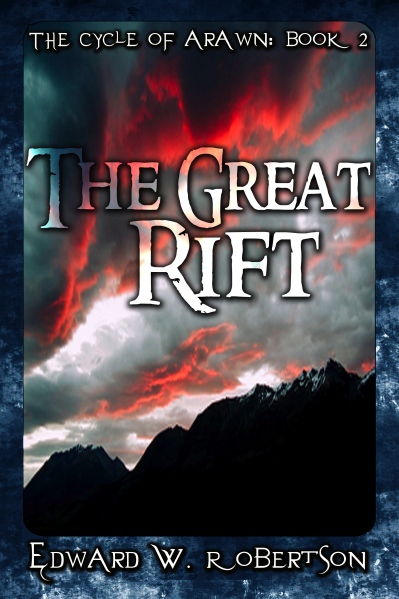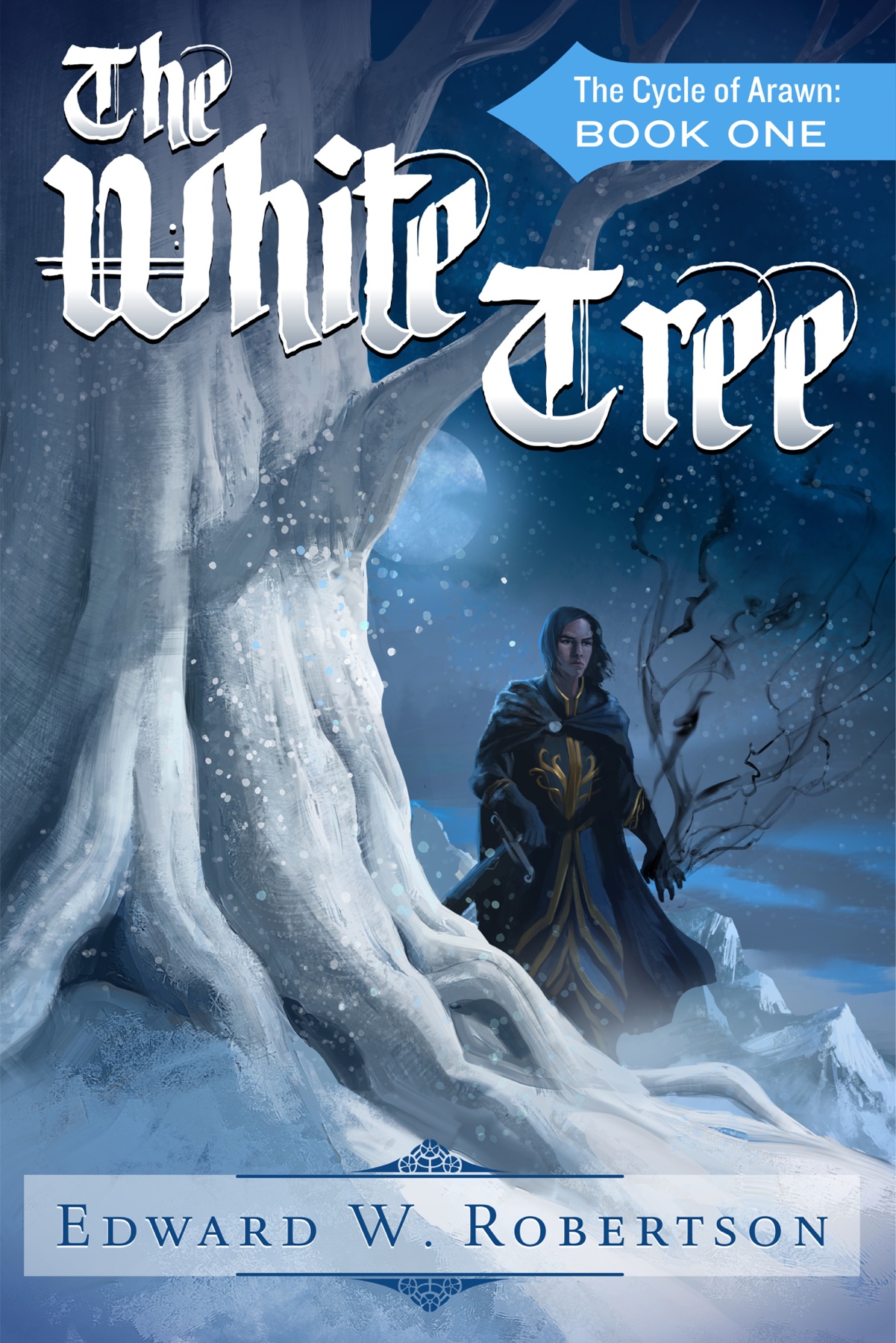Perhaps you’ve noticed I haven’t been posting much this month. Or perhaps you haven’t noticed anything different! We all have our own priorities. But I haven’t been posting, mainly because I’ve been nipples-deep in another project: putting the finishing touches on my newest novel, The Great Rift.
The Great Rift is the second book in my epic fantasy series The Cycle of Arawn. To celebrate its release, the first book The White Tree is currently free (and will be so for the next few days).
Meanwhile, The Great Rift is just $2.99, half off its regular price of $5.99.
According to Amazon, The White Tree is 417 pages long (150,000 words), and normally sells for $4.95. The Great Rift is a whopping 575 pages (nearly 200,000 words) and will normally sell at $5.99. In other words, that’s nearly 1000 pages of epic fantasy for $2.99, or 73% off. Numbers!
This is the first time I’ve had the first clue what to do with a new release. If you like what I do on this blog–you know, the numbers and such–and The Great Rift sounds like it might be worth a read, consider its purchase an investment in future content. The more I sell, the more I learn about how to sell! The more I learn, the more I can talk about what I’ve experienced and what you might try for yourself! Everyone wins and gets rich and life is wonderful forever. This is how you sell something, right? Insane promises?
Anyway, some discussion of price, strategy, etc. after this lovely picture of the cover (artwork by Char Marie Adles):
So, when most indie books are $2.99 or $3.99, with a handful doing battle at $4.99, why $5.99? Well, because this book is super damn long. I worked the better part of 8 months on it. 200,000 words is a lot of words. As it turns out, it is 200,000 of them. To put it in different terms, that’s 2-3 times as long as most of the books written these days. From a financial, conquer-the-world standpoint, it would have been smarter to split it in half and sell two books at $3.99 or $4.95. But that would have messed with the story. It would have made it worse, I think. I don’t want to make my books worse.
So I’m hoping people won’t be put off by the fact it costs $1-3 more than many indie books. It’s twice as long, after all, and if I know one thing about writing, it’s that volume is the only thing that matters!
In general, “hope” is not a great business strategy, but I’ve spent the last month selling Breakers at $5.99 and $7.99, which has proven to me that.. I can sell Breakers at $5.99-7.99, when it has plenty of Amazon visibility behind it and 59 generally positive reviews in a completely different genre than The Great Rift. But I have also learned $5.99 is not necessarily a death sentence. Maybe I can sell there.
And if I can sell there, then I can justify writing books this long. And if I can’t sell there, well.. bummer. Because I think this book kicks ass. And I really want to write the finale to the trilogy.
The underlying point is this: I talk a lot about numbers and algorithms and strategies. At times it probably sounds very calculated and mercenary. Like min-max gamers in World of Warcraft who’ve forgotten how to have fun. Examining this stuff is very fun to me, because there is an underlying logic that can be brought to life if you look closely enough and long enough.
But that’s not ultimately why I do this. I do this to write cool books. Books I can be proud of. (When I’m not overcome by Acute Author Shame Syndrome, at least.) If you’re a writer, I bet you feel exactly the same.
When I’m prattling on about the numbers, then, and the numbers tell you to do one thing but your instincts as a writer tell you to do something different–ignore me. Forget the numbers. Do what makes you happy. This is supposed to be your dream job. Treat it as just that.
Last time I looked at Amazon’s current algorithms, I speculated what would happen 30 days after Breakers‘ giant free run. At that point, all the free copies it gave away would stop counting towards its rank on the popularity lists. That was a frightening prospect, but at the same time, I’d racked up some 2300 paid sales (and another 600 borrows) in the 30 days since my giveaway. Would those be enough to sustain my place on the pop lists? If not, what would happen? Would I face a slow decline, or a swift one? Would I stroll down a hill, or smash down a cliff?
Well, here’s a look in chart form. Here’s Breakers‘ entire sales history:
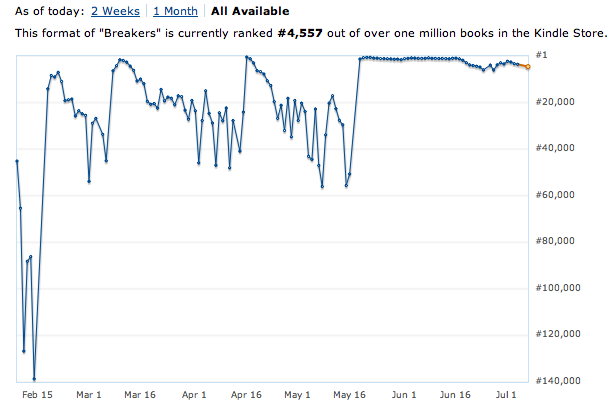 |
| Pictured: D’oh |
That doesn’t look so bad. That nice, flat line goes on forever and ever. It’s just a little jagged there at the end is all. Wait, let’s take a closer look:
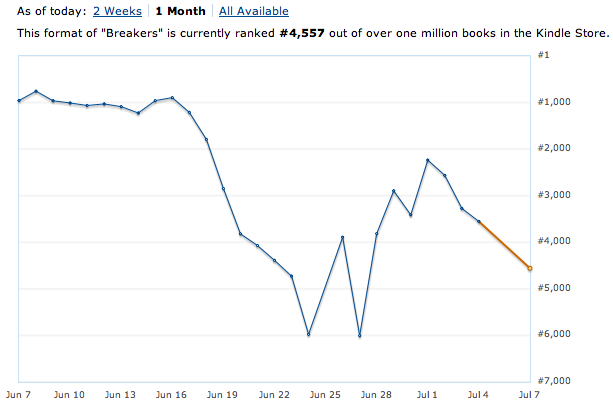 |
| Pictured: D’oh, Part 2 |
Okay, that’s a better look at what happened. What we’re seeing here is twofold. First, notice that downward slope starting around June 16? That’s when my free days stopped counting. The descent was swift–nearly 1000 ranks a day until I hit #4000, when the decline slowed. That is not a gentle hill. That is a brutal cliff. The drop from #1000 Paid to #2000 Paid is the difference between roughly 70 sales per day and about 40 sales/day. And rank declines more slowly than it rises, meaning my drop was even stiffer than that. Within a week of my free days beginning to roll off, I’d dropped from #1000 to #5000. In terms of daily sales, that was a drop from 50-70/day to 10/day.
I had braced myself for it, but it’s hard to brace yourself for a freefall. Mostly what happens at the end of the cliff is a puddle composed of you.
“But wait,” you say. “Bottoming out at #6000 isn’t so bad. That’s a pace around 500 sales/month. And anyway, rank spiked just a few days after that, taking you back to #2000. What are you bitching about?”
What am I–? Look, we’ll get to that in a moment, Captain Impatience. First, I want to talk about the why some more. Why such a steep decline? After all, my bestseller rank was still really good. #1000 overall, which was something like #8 in Technothrillers and #22 in Science Fiction > Adventure. That’s quite a bit of visibility, isn’t it? And what about also-boughts? At that point, I had a lot of popular sci-fi books pointing back to Breakers in the form of the “Customers Who Bought This Item Also Bought” lists.
Well, it turns out those things just aren’t all that important. Ha ha! That is way too flippant of an answer. Totally misleading. In truth, bestseller rank and alsobots clearly matter to some degree, but the more I do this, the more dismissive I am of them in general: while they certainly help generate sales, the bestseller lists are so volatile your book can sink extremely rapidly, and the alsobots are such a harsh filtering process (basically, your book needs to be on the first page of a book that has just been finished by a reader who is interested in buying another book right now) that they are of limited use. I think if you have a very high bestseller rank, or first-page placement on the alsobots of a very popular book, then that can do a lot for your sales, but otherwise, those are the supporting cast to a book’s sales, not the star.
The star is the popularity lists. And your book isn’t on just one of them, it’s on a bunch. For instance, one of Breakers‘ category paths is Kindle Store > Kindle eBooks > Science Fiction > Adventure. Each of those is a separate popularity list, which means the book is listed (somewhere) on each of them. Say it’s showing up at #20 on > Adventure; that would place it somewhere around #40-50 in > Science Fiction, and somewhere like #1200-1600 in > Kindle eBooks. In terms of discoverability, it would be very easy to find in SF > Adventure (second page), pretty easy to find in > Science Fiction (page 4-5), and totally awful in > Kindle eBooks (page 100+). No one is going to click through 100 pages in the eBooks category to find it. But this is part of the reason mega-popular books like 50 Shades of Grey or The Hunger Games stay so sticky for so long: when you’re #1 in the store, everyone sees you every time they visit Amazon. Plus the whole “world-destroying word of mouth” thing. But extreme visibility in high-traffic categories leads to a lot of clicks on your book, which in turn generally leads to a lot of sales.
That’s essentially why Select free runs used to do so well on the old pop lists. And that’s why taking a sudden tumble from, say, #10 in > Science Fiction (where I peaked)–the first page of the entire category–to #40-50 or wherever makes such a big difference. And remember, you’ve got another subcategory you’re listed on, too. Once your visibility is lost when a big free run rolls beyond the pop list window, you’re not going to regain it without another push.
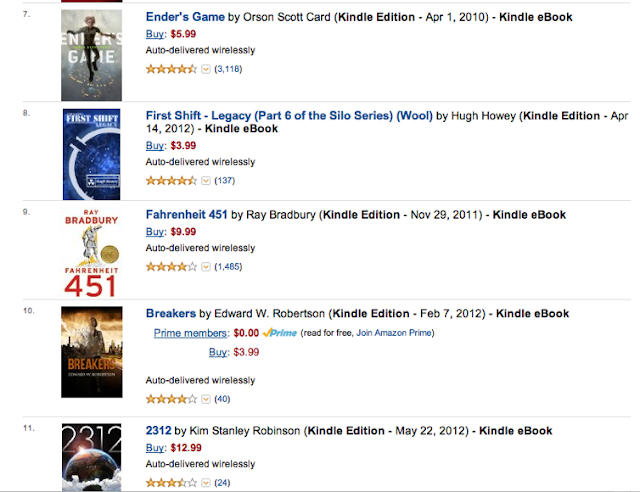 |
| Breakers’ peak rank on the Science Fiction popularity list a week before I ate cliff |
Want to know the best part about finally (if however temporarily) doing well with a book? The sales. Ha ha ha! But the other best part is the sense of having written something other people liked. That’s been my dream for the better part of two decades now, and so it’s fairly surreal to get reviews for Breakers like the newest one at Sippin’ Southern Sass.
I won’t rehash the whole review, but like I said over there, there’s no better way to flatter an author than to compliment their prose.
Neat thing about this modern writing world: the author of the review, LM Gautreaux, found me because we both hang out on Kindleboards. Back in the day (2009!), Kindleboards was touted as a way to sell your book directly to readers, but if that was ever effective, I don’t think that’s its primary purpose anymore. Instead, it’s a place to network with other writers and learn how to sell books–which can be vastly more complicated than “write book, release book.” Everything I know about Amazon’s algorithms started from reading posts on Kindleboards. But posting there is also simply about being accessible.
Being accessible is important. I know that’s not for everyone; writing is often a solitary business, and it draws a certain set, self included, that are often averse to public interaction. But even if public message boards aren’t for you, if you’re an author, I highly recommend sticking your email address at the back of your book. Create a way for fans to get ahold of you easily. They can be a tremendous resource. A few of the people who wrote to me about Breakers or The White Tree wound up being beta and gamma readers for my most recent novel, and they made a huge difference in its quality.
Anyway, this is getting far afield. Point is, even when you hire professionals, it’s hard to do this on your own. Let other people give you a hand, whether it’s by reviewing your book or beta reading before you go live. But it’s much harder for people to find you–and thus help you–without having a public face somewhere.
On a different note, you may have noticed: there haven’t been any posts here in three weeks! Well, that’s because I’ve been absurdly busy. I am about to become less busy. Differently busy, at least. Busy in a way that means I still have access to my computer. With any luck, then, tomorrow I’ll wrap up the series on Amazon’s algorithms with Part 5: Eating Cliff.
As the headline says, I’ve been interviewed at Up Your Impact Factor, a blog about getting by in modern times. What do we talk about? Well, the changes to Amazon’s algorithms, of course, as well as what it means for Select.
Yesterday, Joe Konrath and Blake Crouch put up an interesting post on Amazon’s Select program. The gist is that, with the emergence of viable alternative ebook stores besides Amazon, staying exclusive to Amazon by participating in the Select program is no longer worth it.
I’d qualify that a bit: staying exclusive to Amazon is no longer worth it for bestselling authors J.A. Konrath and Blake Crouch.
I’m sympathetic to their message. For 98% of participants, Select is no longer as powerful as it used to be. It doesn’t rack up the sales like it did just a few months back. Meanwhile, over the last couple years, Amazon’s share of the ebook market has decreased from around 90% to 60% or less. Still huge, in other words, but the other stores are no longer irrelevant. To put it in perspective, let’s look at a completely hypothetical example. Say you’ve got a book that will earn $300 through Amazon each month. Back when Amazon had 90% of the market, you’d only expect to earn another $33 by distributing to all the other stores. These days, having it available everywhere would make you another $200 per month. In an environment where gaining the perks of Select only means giving up 10% of the market, it’s a pretty easy call. When that exclusivity means giving up 40%, it’s a completely different story.
Blake illustrates this by his experiments with Barnes & Noble and Kobo. By enrolling in the Nook First program with his latest book, Eerie, he was able to sell 1500 books in a month of exclusivity–pretty good. Far better than he would have done for the Nook without the advertising and placement B&N gives its Nook First authors.
With another book, Kobo offered him a real promotional flurry–“email blasts, coupons, and prominent placement on their landing pages”. He didn’t have to go exclusive with them, and he was still able to hit the top 10 on Kobo. That month, his Kobo earnings on that title nearly matched what it made on Amazon.
This sounds really good. Much better than the dwindling returns of Amazon Select. But then again, of course it sounds good: this is Blake Crouch we’re talking about.
Blake Crouch can get into Nook First. Blake Crouch can get a massive advertising push on Kobo. Can you? Without those resources at your disposal, how do you really think you’ll do on the other stores? Better than you’d do than if you stayed in Select?
This doesn’t mean I think Select is still the end-all and be-all in the indie world. Kobo is very interesting, and some people do well on B&N. Despite my recent success with it, I’m growing increasingly disenchanted with Select myself; a week back, I scheduled a two-day free run for Breakers that had a good shot restoring its sales, but the promo didn’t begin until 2 AM on the second day. I emailed, called, and emailed Amazon again to reschedule my lost free day for the following day, but they didn’t respond until it was too late. The giveaway went decently, but without that second day, it didn’t do nearly as well as it would have. I gave away some 5600 books; with another day, I probably would have done 8-9K. In my position, that could have been huge. Amazon’s slow customer service cost me hundreds, possibly thousands of dollars.
Guess who’s pretty interested in Kobo and iTunes right now?
But I’m still not pulling everything from Select right away. I have a plan for one of my books that hinges on what Select offers. Select can still help that book better than anything I’m aware of through iTunes, B&N, and Kobo put together.
We’re not all Blake Crouch. I’d like to be Blake Crouch. It would be much easier to make these kinds of decisions when the other stores are willing to put so much marketing muscle at your disposal. In the interest of full disclosure, the only reason I’m leaning toward pulling one of my books from Select is I’ve had an offer–at a much, much smaller level–that would provide it with some visibility there. That, combined with my growing disenchantment with Select, makes me inclined to experiment.
The bottom line is very much a matter of common sense: if Select isn’t getting you much in the way of results, you should totally try the other stores and see what happens. Experimentation is key. You have to fail and fail and fail until you find what works. But if Select is helping, even modestly, or you have a strategy to make it start working for you, then you should probably stay exclusive for now.
Blake gets at that in their post, actually. He concludes by saying that he doesn’t have definitive answers, that the real answer is to experiment and adapt–but Joe pushes harder against Select. He no longer thinks exclusivity is worth it.
Well, maybe not for him. But it still might be for you.
So in my last look at the iTunes storefront, I saw that Apple’s bestseller lists appear to be extremely volatile. I guessed that volatility was due to low total sales, meaning just a single sale or two could cause a big swing in your book’s rank. I saw my novella The Zombies of Hobbiton jumping up and down the lists and surmised it was averaging about a sale per day.
Well, a couple weeks ago, Smashwords updated my sales figures. In May, The Zombies of Hobbiton sold 8 copies on iTunes. Wait, what?
On the surface, that makes no sense–it was climbing back up the ranks every single day. Every morning, I’d open iTunes, and I’d see it around #30 in its categories. One morning, #34. The next morning, #35. The one after that, #34. Next day, #34 again. It was almost as if, instead of being boosted by overnight sales, it was just returning to the exact same ranking it had yesterday…oh. Oh, I see.
Before my sales figures came in, I already had a sneaking suspicion of what was happening: Apple’s ranks move around a lot during the day, then snap back to their “correct” ranking every morning. That ranking draws on a very long sales history–at least the last two months, maybe much longer. With low total sales across the storefront (or at least in the category of Science Fiction & Literature), and a long window in which sales are credited towards your rank, you can go days on end without a single sale and still get boosted back to your old rank every morning.
That ranking system of “float freely during the day, snap back every 24 hours” is massively different from the very linear ranking systems I’m used to seeing on Amazon and B&N. But I kind of like it. Snapping back every morning ensures ongoing visibility, while the high volatility during the day allows for books that sell a few copies to fly up the charts and maybe sell a few more.
The other implication here is that iTunes is very sticky. Get a book highly-ranked, and it will be there for a goodly while, leading to regular (if quiet) ongoing sales. But that same mechanism means it’s going to be hard to get sticky in the first place.
That’s all the insight I’ve got for now. But the iTunes storefront is pretty interesting, and while the rewards are significantly lower than doing well on Amazon, it doesn’t seem far-fetched to sell enough copies there to do pretty well for yourself. I’m still not sure what to make of the Select conundrum, but the potential of iTunes and Kobo is really starting to pique my interest.
So have I mentioned I’m currently participating in a $0.99 sale with a bunch of other authors? No! I didn’t! Because I’m a bad man whose life has gotten much busier than I’m used to. Anyway, here’s the deal: we’ve got 11 books, including fantasy, thriller, romance, and historical fiction, all priced at $0.99–including what will soon be the newest Kindle Single, George Berger’s Midnight’s Tale. There are some very popular books up right now–Mel Comley’s latest thriller, Monique Martin’s Out of Time (the series to which she’s just released the third book), and of course my someselling epic fantasy novel The White Tree–sequel coming out next month.
Technically speaking, this sale ends after today, but if you’re coming at this even later than I did, I’m sure several of the authors will keep their books discounted for another day or three. Give ’em a look. I said look!
The other day, I read this post by Rolando Garcia looking at trends among Amazon book reviews. He identifies several distinctive distribution patterns among reviews and noted that there may not be any books that have a majority of three-star reviews.
I don’t really have anything to add to his study. I just thought it was neat and interesting and apparently very thorough–he mentions that he looked at 4000 different books to put this together! A trainspotter after my own heart.
From here, it would be particularly cool to take a look at each different distribution pattern and try to identify what kind of book provokes that particular pattern. For instance, his example with Hugh Howey’s Wool would probably be “the fan favorite” whereas Robert Jordan’s Crossroads of Twilight would be like “the former fan favorite who has finally pushed all those fans to the breaking point.” If you had a significant enough number of reviews on one of your own books to see a clear pattern, you could compare it to the catalogue of distribution patterns and get a pretty good idea of what kind of book you wound up writing.
Which.. might just be a roundabout way of confirming something you already knew. Still. It would be interesting! I swear!
In my last post examining the effects of a large free run under the current algorithms, I looked at how Breakers‘ sales had been in the week after giving away 25,000 copies. They looked steady. And given that the book would have very strong position in the popularity lists for 30 days, my best guess was that sales would stay strong throughout that period.
Still, that was just a guess. And I thought it was also quite possible that sales would slow. Significantly so, even–maybe regular browsers of the popularity list would all snap it up in the first few days, leaving it much more sluggish after that. There was no way to know for sure until more numbers came in.
Okay, by my count, it’s now been 17 days since Breakers reverted to paid. Here’s a look at its last 30 days of sales:
That is a line. An almost-straight one. That line represents numbers that are frankly humbling and my-mind-blowing; I’m not sure how to address this without it coming across as bragging. That line represents some 1250 sales and 400 borrows.
Yet it’s also a bit deceptive. That graph is measuring all numbers between #1 and #60,000. How does it look at a more micro level? Here’s the graph for the last two weeks:
By Authorcentral, it peaked May 22, ending the day at #550. It declined every single day after that, reaching its nadir at #1583 on May 31. On June 1, it leapt to #1099; it reached #821 by June 3, and while that graph isn’t showing its latest increase, at 12:45 PM June 5, it’s at #852.
What caused the rebound? Borrows are a big part of it. Breakers has been listed at #1 in Science Fiction in the Kindle Online Lending Library for at least a week now. Despite the top placement in its genre, in the last four days of May, Breakers had 37 borrows, averaging 9.25/day. In the first four days of June, it’s had 110–27.5/day. Clearly, most Prime members had exhausted their monthly borrows by the end of the month; as their borrow refreshed June 1, many new readers snapped up the book.
But an extra 18 borrows a day isn’t quite enough to boost it from #1600 to #800. The borrows can be explained by the start of a new month, but raw sales are also up, too, from 57.75/day in the last four days of May to 77.5/day over the first four days of June. That’s a 34% increase(?!?).
How to explain that? I don’t know. Its pop list ranks have been steady for days now. Presumably, as borrows came in, boosting Breakers‘ rank on various bestseller lists, the additional visibility led to a few more sales, but I don’t think that’s the only–or even the primary–driver of these extra sales. Its bestseller ranks haven’t rebounded that much. All I can offer on this front is conjecture: Are shoppers more free with their money early in the month? Does Amazon send out extra recommendation emails at the start of the month? It’s also gotten 23 new reviews since going free (it had just 9 before); is that helping to convince shoppers to click “buy”?
I don’t know. All I can conclude is that a free giveaway can pay off heavily in borrows as well as sales–right now, Breakers is #12 on the popularity lists in all Science Fiction, but none of the books above it are enrolled in Prime, meaning it gets the #1 spot in the KOLL. The frenetic pace of early-month borrows is already slowing, but that was a nice shot in the arm–my sale : borrow ratio is currently at almost exactly 3 : 1. I believe very few of those borrows are cannibalized sales. My gut feeling, having seen numbers on a bunch of other books, is that a more “normal” sale : borrow ratio would be more like 10 or even 20 : 1. In other words, a full ~25% of my total income so far this month is directly due to having such ridiculously high placement in the KOLL.
17 days in. That gives me another 13 before my free downloads slide beyond the 30-day window of the popularity lists. In another two weeks, then, I expect the gravy train to run out of steam. Possibly to fly off the rails altogether. But it won’t vanish from the popularity lists altogether–by then, it’ll have somewhere in the neighborhood of 2000 sales credited to its ranks, meaning it might only drop from page 1 to page 2 or 3. Even so, that could lead to a death spiral, a negative feedback loop where lower visibility –> lower sales –> even lower visibility –> even lower sales, but we’ll see.
Wherever it goes from here, I can’t consider this as anything but a success. It’s been fascinating to watch, and from a personal angle, it couldn’t have come at a better time–my fiancee’s workplace is reducing everyone’s hours, and our ability to scrape by, already rocky, might have become downright jagged. Even if it crashes and burns in another two weeks, it’s already saved our bacon.
